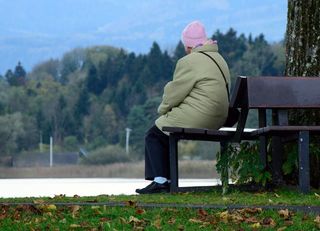Almost everyone will experience a feeling of loneliness at one time or another—for example, when our family members are away on a trip, when grown children go off to school, when a social group disbands, or when a good friend moves to another city. There are many circumstances that can trigger a sense of loneliness. This is known as situational loneliness, and these feelings are generally temporary and pass after a short time. There is another kind of loneliness called chronic loneliness.

Chronic loneliness is a feeling of persistent sadness that can last indefinitely.1 This is a much more serious problem, and it affects people in care homes at more than twice the rate it affects people living in the community.2 An unmet need for meaningful relationships combined with a sense of having lost their self-determination due to having been moved to a residential facility play a crucial role in the development of feelings of isolation and loneliness.2
Chronic Loneliness & Health
If left untreated, chronic loneliness can lead to serious medical and emotional problems including:
- cognitive decline and progression of Alzheimer’s disease2
- recurrent stroke2
- obesity2
- elevated blood pressure2
- heart disease3
- depression3
- sleep disorders3
- type 2 diabetes3
Chronic loneliness has even been associated with a shortened lifespan.2,3
Identifying Chronic Loneliness
There are no formal criteria for diagnosing chronic loneliness, but because the condition is closely associated with depression and depressive disorders, the signs and symptoms are usually very similar. If you suspect a loved one may be experiencing chronic loneliness, watch for any of the following:1
- loss of interest in things that used to be pleasurable
- feelings of hopelessness
- disruption of sleeping patterns
- feeling tired and having little energy
- either poor appetite or overeating and gaining significant weight
- difficulty concentrating
- poor self-esteem
- suicidal thoughts
The appearance of these indicators of chronic loneliness signals the need to consult a healthcare professional.1
Preventing Chronic Loneliness
Preventing chronic loneliness in people living in residential facilities is just as important as seeing to their personal hygiene.2 This involves fostering a sense of social connectedness, and that means engaging with others in a positive, healthy way.3 This can be particularly difficult during the COVID-19 pandemic when residents must be protected from the risk of infection, and family member may hesitate to visit for fear of transmitting the virus.
One answer to this dilemma could be professional care sitters who are trained in the methods necessary to keep everyone safe and protected from infection. For more information on this valuable service that can protect your loved ones on multiple levels, click here.
References
1. Nelson JA. Chronic Loneliness: Causes, Symptoms, and Health Risks. eMediHealth. Available online at https://www.emedihealth.com/chronic-loneliness.html.
2. Simard J, Volicer L. Loneliness and Isolation in Long-Term Care and the COVID-19 Pandemic. Journal of Post-Acute and Long-Term Care Medicine. 2020 Jul;21(7):966-967. Available online at https://www.jamda.com/article/S1525-8610(20)30373-X/fulltext.
3. Signs and Symptoms of Chronic Loneliness. Cigna. March 2019. Available online at https://www.cigna.com/individuals-families/health-wellness/chronic-loneliness
.


